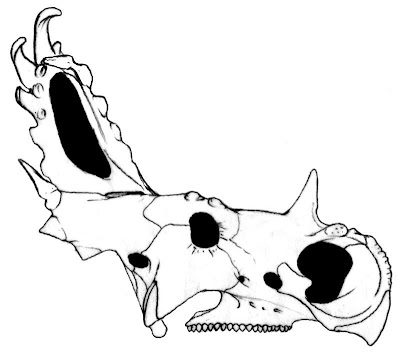
Sinoceratops zhuchengensis
• the First Ceratopsid, Horned Dinosaur, from China
Image Credit: Olorotitan on DeviantArt

Abstract
Ceratopsid dinosaurs represent one of the best known dinosaur groups in the Late Cretaceous, and their unquestionable fossil records are exclusively restricted to western North America. Here we report a new ceratopsid dinosaur, Sinoceratops zhuchengensis gen. et sp. nov., from the Upper Cretaceous Wangshi Group of Zhucheng, Shandong Province, China. Cladistic analysis places this new taxon as the only known ceratopsid from outside North America, in a basal position within the Centrosaurinae. It is con-siderably larger than most other centrosaurines but similar in size to basal chasmosaurines. Furthermore, it is more similar to chasmosaurines than to other centrosaurines in several features, thus blurring the distinction of the two ceratopsid subgroups. This new find not only provides significant information on the morphological transition from non-ceratopsid to ceratopsid dinosaurs, but also complicates the biogeography of the Ceratopsidae, and further demonstrates that fossil sampling has profound effects on recon-structing dinosaurian biogeography.
Keywords: Late Cretaceous, Wangshi Group, Ceratopsidae, Centrosaurinae, biogeography

Figure 1: Photograph of Sinoceratops zhuchengensis holotype. ZCDMV0010 skull in right lateral (a) and right laterodorsal (b) views; ZCDMV0010 parietals in dorsal (c), posterior (d), and ventral (e) views. Abbreviations: bp, bump; ff, frontal fontanelle; mb, median bump; mr, midline ramus;nb, nasal bump; nh, nasal horn; ob, orbit; pb, postorbital bump; sb, supraorbital bump. Scale bar = 8 cm for (a), (b) and 6 cm for (c), (d), and (e).

Sinoceratops zhuchengensis
— the First Ceratopsid, Horned Dinosaur, from China
Xu, X., Wang, K., Zhao, X. & Li, D. (2010). "First ceratopsid dinosaur from China and its biogeographical implications". Chinese Science Bulletin. 55(16): 1631–1635. DOI: 10.1007/s11434-009-3614-5.